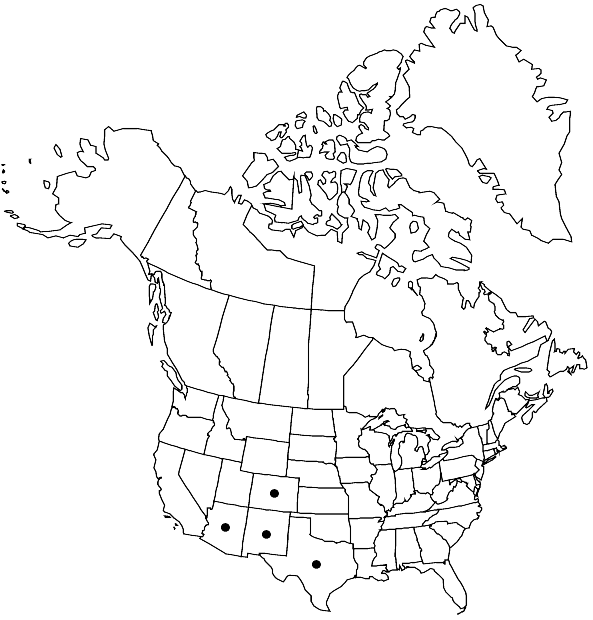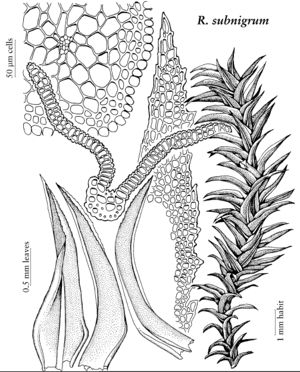Rhexophyllum subnigrum
Beih. Bot. Centralbl. 50(2): 684. 1933,.
Plants in loose, wiry turfs. Stems robust, often branching, without tomentum, few coarse, redbrown rhizoids at the stem base or occasionally higher and more abundant in robust plants. Cauline leaves 1.8–2.5 mm, at least some leaves with tattered laminae; most apices present, tending to epapillose; distal surface cells on costa roughened abaxially by distally-projecting papillae at distal ends of cells; basal-cells gradually differentiated from distal laminal cells, pale-yellow, smooth, 15–17 µm wide; distal laminal cells 7–11 µm wide.
Habitat: Not fertile in the flora area. Shaded rock faces or clefts
Elevation: moderate to high elevations (2000-2500 m)
Distribution

Ariz., Colo., N.Mex., Tex., Mexico, South America (Bolivia), South America (Peru)
Discussion
Rhexophyllum is characterized by leaves deeply keeled, lanceolate from an ovate base, squarrose-recurved above a sheathing leaf base when moist, with sharp, deep to shallow, irregular marginal teeth, 2-stratose distal lamina, occasionally splitting to the costa, and by the red color of the lamina both naturally and in 2% KOH. Material from the study area may have leaves more distant on the stem proximally, the stems appearing more thinly foliose. Sometimes the marginal teeth are pronounced, sometimes low or eroded. The lamina may be slightly to almost completely 2-stratose. The degree of fragility is also variable.
Species of Leptodontium are similar in their squarrose leaves, but these are yellow, 1-stratose, not fragile, have larger distal laminal cells and fewer papillae; Leptodontium also lacks a stem central strand and has peristomate capsules, the abaxial surface of the costa is smooth, whereas it is distally roughened-papillose in Rhexophyllum. Characters of Rhexophyllum subnigrum growing in North America may depart from those expressed under optimal habitat conditions, as given in the generic description above. Plants from the American Southwest may strongly resemble species of Grimmia, which are common there and with which Rhexophyllum may grow. Rhexophyllum differs in its coppery, brick-red color, and strongly keeled leaves with irregularly thick-walled limb cells that become transversely flattened (1:
Selected References
None.
